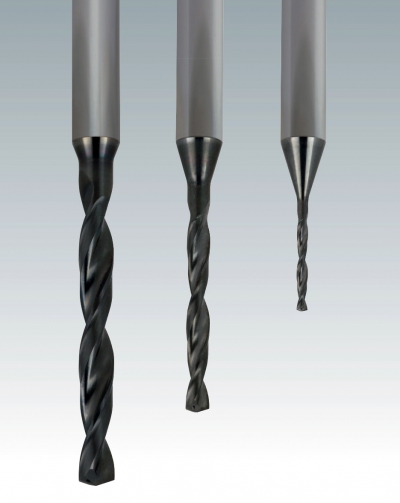
Emuge Corp. announced it has expanded its EF-Series of high-penetration rate drills with a new line of submicrograin carbide coolant-fed microdrills. The EF high-performance microdrills range from 0.0295 in. (0.75 mm) up to 0.1181 in. (3.0 mm) in diameter, are all coolant through design, and are ideal for aerospace, medical and precision automotive applications designed for producing very small deep holes in steel, cast iron, stainless steels and nonferrous materials. All tools are 6xD length and can accommodate most production applications.
The unique face geometry of the EF Micro Drills generates short chips in the drill operation, ensuring high drill hole accuracy. The micro face point and flute geometry, in addition to the coolant-fed design enable excellent chip evacuation for the highest possible drilling speed, while reducing the need for peck cycles or clearing chips, according to the company. The drills have a TiALN T99 multilayer PVD coating for added heat and wear resistance. This significantly reduces built-up edges and edge chipping, substantially increasing tool life. In addition, the large central tool shank channel guarantees maximum coolant intake capacity, allowing optimal coolant transfer.
The internal coolant supply enables economically efficient, high performance machining down to even the smallest drilling diameter of 0.75 mm. Drills also feature a double margin design for added stability and superior hole surface finish.
Emuge EF drills are the result of extensive R&D and incorporate special geometry, proprietary carbide grades and a PVD coating design that is unique to the industry. The result is three to five times faster penetration rate than conventional carbide and cobalt drills, in addition to exceptional, high-quality threads and longer tool life.
Contact Details
Related Glossary Terms
- coolant
coolant
Fluid that reduces temperature buildup at the tool/workpiece interface during machining. Normally takes the form of a liquid such as soluble or chemical mixtures (semisynthetic, synthetic) but can be pressurized air or other gas. Because of water’s ability to absorb great quantities of heat, it is widely used as a coolant and vehicle for various cutting compounds, with the water-to-compound ratio varying with the machining task. See cutting fluid; semisynthetic cutting fluid; soluble-oil cutting fluid; synthetic cutting fluid.
- physical vapor deposition ( PVD)
physical vapor deposition ( PVD)
Tool-coating process performed at low temperature (500° C), compared to chemical vapor deposition (1,000° C). Employs electric field to generate necessary heat for depositing coating on a tool’s surface. See CVD, chemical vapor deposition.
- shank
shank
Main body of a tool; the portion of a drill or similar end-held tool that fits into a collet, chuck or similar mounting device.
- stainless steels
stainless steels
Stainless steels possess high strength, heat resistance, excellent workability and erosion resistance. Four general classes have been developed to cover a range of mechanical and physical properties for particular applications. The four classes are: the austenitic types of the chromium-nickel-manganese 200 series and the chromium-nickel 300 series; the martensitic types of the chromium, hardenable 400 series; the chromium, nonhardenable 400-series ferritic types; and the precipitation-hardening type of chromium-nickel alloys with additional elements that are hardenable by solution treating and aging.
- titanium aluminum nitride ( TiAlN)
titanium aluminum nitride ( TiAlN)
Often used as a tool coating. AlTiN indicates the aluminum content is greater than the titanium. See coated tools.
- wear resistance
wear resistance
Ability of the tool to withstand stresses that cause it to wear during cutting; an attribute linked to alloy composition, base material, thermal conditions, type of tooling and operation and other variables.







